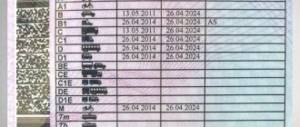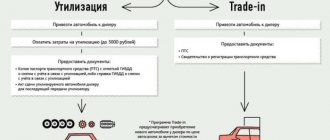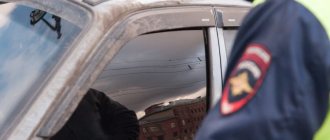What are the 4 essential items you need to carry in your car?
Everything here is simple and clear... On the one hand. After all, we are talking more often about passenger cars. And for them the required attributes are:
- first aid kit,
- fire extinguisher,
- warning triangle,
- reflective vest.
But there are also trucks, motorcycles and buses. So, the following compulsory subjects are provided for them:
Trucks under 3.5 tons are the same as for passenger cars.
Trucks over 3.5 tons and buses with a maximum weight over 5 tons :
- first aid kit,
- fire extinguisher,
- warning triangle,
- reflective vest,
- wheel chocks (at least 2 pieces).
Motorcycles with side trailers:
- first aid kit,
- warning triangle,
- reflective vest.
Motorcycles without a trailer - only a reflective vest.
This is perhaps a comprehensive list for 2021. All of these items, except for the cape vest, are provided for in paragraph 7.7 of the List of Faults (Traffic Regulations Appendix), and the reflective vest is provided for in the new paragraph 2.3.4 of the Rules.
You will also be interested in:
- Is it possible to paint a car in the colors of the police, ambulance or fire services?
- We drove under the camera at a yellow traffic light: will there be a fine and how to appeal?
- Changes in traffic rules in March 2021: new road sign 6.22 Photo and video recording
What should you carry in different categories of vehicles in 2021?
| Vehicle type/item | First aid kit | Fire extinguisher | Vest | AO sign | Wheel chocks |
| Cars, trucks up to 3.5 tons and buses up to 5 tons | Yes | Yes | Yes | Yes | No |
| Trucks over 3.5 tons and buses over 5 tons | Yes | Yes | Yes | Yes | Yes |
| Motorcycles without a trailer | Yes | No | Yes | Yes | No |
| Motorcycles with trailer | No | No | Yes | No | No |
Our verdict
Without a fire extinguisher, first aid kit and warning triangle, you will not pass the inspection. Of course, you can borrow them from friends or neighbors for one day, but all these things are absolutely necessary every day, because an emergency can happen at any moment. Therefore, we recommend purchasing them and always keeping them in the car, checking the expiration dates of the components and replacing them on time, as well as refilling or changing the fire extinguisher in a timely manner. Will it come in handy?
Installation of gas equipment in the Autobusiness database
What is the penalty for missing these items?
The measure of punishment has its own subtleties. Let’s look at how to avoid it below, first about the norms and amounts of fines.
Fine for first aid kit, fire extinguisher and triangle
For the absence of these items, the fine is 500 rubles. And in rare cases, you can get away with a warning - in practice it is issued very rarely if the driver has no fines at all, but in theory it can be if there are mitigating circumstances.
The norm of 500 rubles is established by part 1 of article 12.5 of the Code of Administrative Offenses, which provides for punishment for violating the list of faults for which the operation of a car is prohibited. That is, the above Traffic Regulations Appendix.
It is important that if you do not have a fire extinguisher, a first aid kit, or an AO sign, then only one fine can be issued, and not 3, since it is the very fact of driving that is punished in the presence of conditions prohibiting driving without these items listed in clause 7.7 List of faults.
Another subtlety of the penalty is for the absence of a triangle. If you do not have it in case of an accident, then you are subject to qualification under another administrative norm - part 1 of Article 12.27 for failure to display the AO sign in the event of an accident with a penalty of 1000 rubles. And this is legal. That is, in fact, in this case you will already receive 2 fines.
Penalty for reflective vest
There is no one for 2021. The point here is that the clause in the Traffic Rules obliging you to carry it with you and wear it under certain circumstances was introduced quite recently. And they haven’t yet come up with a fine for his absence.
Consequently, any attempts by a traffic police officer to charge you for not wearing a cape vest are unlawful - there is no article in the Administrative Code that would punish for this.
Otherwise, read the article and its part of the Code of Administrative Offences, indicated in the resolution on the violation - it must be there; without specifying the norm, the resolution is invalid. This article will not make reference to clause 2.3.4 of the traffic rules – neither specific nor general (indirect). List of fines for not having required items in the car
| Item | Fine | Article of the Administrative Code |
| For the first aid kit | 500 rubles | 12.5, part 1 |
| For the fire extinguisher | 500 rubles | 12.5, part 1 |
| For the warning triangle | 500 rubles and another 1000 rubles in case of an accident | 12.5, part 1, 12.27, part 1 |
| For a reflective vest | No fine | – |
How to avoid a fine for a first aid kit, fire extinguisher and AO sign?
Simple enough. Everything that you are required to present to the traffic police inspector for inspection is specified in paragraph 2.1.1 of the traffic rules. And there are no specified objects there. And a traffic police officer can independently check their presence only in 2 cases:
- as part of a vehicle inspection, which you can refuse or if you yourself declare that you do not have them,
- within the framework of an inspection of a vehicle, for which compelling reasons are needed, and suspicions (unmotivated, however - the refusal to provide them for inspection is not a reason to suspect their absence) of the inspector are not such grounds.
That is, there is an obligation to have them, but not to present them for verification. And there can be a fine only if you yourself admit that you do not have a fire extinguisher, first aid kit or warning triangle in your car.
Something else useful for you:
- Is it possible to order and legally drive without a fine with license plates without the Russian flag?
- Is it necessary to comply with reduced traffic signs?
- New sign “child passengers” in cars according to traffic rules – when will it come into force?
If the fire extinguisher or first aid kit is expired
An interesting nuance - can a fine be issued if you actually have a first aid kit and a fire extinguisher, but their expiration date has expired? This nuance is actually more subtle than it might seem.
On the one hand, clause 7.7 of the traffic rules clearly states that operation of the vehicle is prohibited if this fire extinguisher, first aid kit or triangle is missing That is, a fine should be imposed only for their absence, even if they are overdue.
But it's not that simple! The judge or official reviewing the violation may base his conclusion on the objectivity of the driver’s actions - especially if he was aware that he was driving with expired attributes that must be in the car. The obsolescence of these objects may constitute an offense, since it does not contribute to road safety, just as if they were completely absent.
Is a fire extinguisher required in a car by law?
A fire extinguisher is required to undergo maintenance. Device parameters, types and characteristics are specified in GOST, NPB.
| What is provided | Regulatory acts |
| Fire extinguisher requirements |
|
| Duty to have |
|
What volume of fire extinguisher should be
Manual and automatic units of greater mass are allowed, but not below the prescribed parameters. The device must be intended by the manufacturer for motor vehicles (ATS).
| Cars | Volume not lower (l) | Charge mass (not cylinder) not less (kg) |
| Cars | 2 | 2 |
| Freight |
| |
How many fire extinguishers should there be?
The number of extinguishing devices for vehicle registration and maintenance is regulated by SP 9.13130.2009 (Appendix B, clauses B1 - B2) and the “Fire Safety Rules” (clause 212). The parameter depends on the weight, purpose, and capacity of the machine.
In a car
Passenger cars are equipped with at least 1 product with a charge weight of 2 kg and 2 liters. Required capabilities: extinguishes model fires from 0.7A and 21B.
In a truck
For cargo vehicles you will need:
- for vehicles up to 3.5 t - one (2 kg, 2 l, from 0.7A and 21V);
- trucks for transporting people or weighing from 3.5 to 7.5 tons, combines, tractors - two similar;
- Vehicles from 7.5 tons, transporting dangerous goods (trucks, fuel tankers, tank trucks) - two from 2A and 70B.
In the bus
For buses weighing from 3.5 - 7.5 tons, you will need 2 similar fire extinguishers with a charge weight of 2 kg, 2 liters.
Shelf life of a car fire extinguisher
All containers are subject to a mandatory full check with a change of charge every 5 years, even if all indicators are normal. The manufacturer may also provide for increased frequency of maintenance.
| View | Shelf life for technical inspection (years) | Charge life and recharging (at least) |
| Carbon dioxide | Up to 15 – 20 |
|
| Powder | To 10 |
Charge updates are carried out more frequently if specified by the manufacturer. For example, powder-type automobile fire extinguishers of some models are prescribed to be refilled once every 4 or 1.5 years, and carbon dioxide fire extinguishers - once every 2 years.
Passing the technical inspection includes inspecting the fire extinguishing device, filters, all components, and checking the mass of the charge by weighing.
A full recharge will be required after use or if the charge weight deviates from 5%. The container may be declared unusable ahead of schedule. They don’t restore it – they replace it with a new one.
The release date is indicated on the case by the manufacturer (a piece of paper is torn off opposite the number):
- Arabic numerals – year of manufacture;
- Roman - month.
Expiration and inspection dates are entered by the manufacturer and specialized organizations into technical documents and stickers on the case.
The cost of refilling an OP is almost equal to the price of a new product - as a rule, it is better to buy a new one if its service life has passed.
Fine for not having a fire extinguisher
The list of malfunctions and violations leading to a ban on the operation of a vehicle (clause 7.7 of Chapter 7 of the Traffic Regulations) includes the absence of a car fire extinguisher. If there are compelling reasons, the traffic police inspector inspects the car.
The fine for an expired fire extinguisher or its absence is provided for in Art. 12.5 Code of Administrative Offenses – 500 rubles. Fixed size. The inspector has the right to limit himself to a warning.
What are the requirements for a fire extinguisher?
The requirements for a fire extinguisher are dictated only by the Technical Regulations on the Safety of Wheeled Vehicles, so it has no direct responsibilities for the driver.
Thus, the regulations provide the following rules:
- Each car and motorcycle must have a place for its installation (clause 1.15.6.3): for passenger cars - 1 fire extinguisher with a volume of 2 liters,
- for trucks over 3.5 tons - 2 fire extinguishers: one - 2 liters, the second - 5 liters,
- for buses - 2 fire extinguishers, one of which should be located near the driver’s seat.
Where is the fire extinguisher located in a car according to traffic regulations?
The main criterion for proper storage of a device is its availability in case of an emergency.
The rules stipulate that a fire extinguisher should be stored in the vehicle cabin, and not in the trunk or additional containers found on trucks. The structure must be securely fixed in a place convenient for use. The device can be fixed using a special bracket. The driver's actions in the event of a fire must be clear and meaningful. To do this, he must read the instructions for use of the device. It must be applied to the body of the fire extinguisher and be clearly readable. The driver's procedure involves the following:
- break the seal on the check of the structure;
- pull the pin from the place of fixation by the metal arc;
- point the fire extinguisher at the source of the fire;
- squeeze the lever bracket.
The total release time of the fire extinguishing agent is about 10 seconds. There may be a slight delay due to the design of the fire extinguisher. The greatest effect is achieved by a continuous jet directed from a minimum safe distance to the center of the fire.
What are the requirements for a first aid kit?
A first aid kit has almost the same placement requirements as a fire extinguisher: a place to install it in the car. But there is no requirement for accessibility from the driver's seat. It must also not be expired.
The composition of the first aid kit, according to the new Order of the Ministry of Health No. 1080N, should be as follows:
- tourniquet to stop bleeding,
- sterile and non-sterile bandages of various widths,
- sterile dressing bag,
- gauze napkins,
- adhesive plasters of various widths, including rolled ones,
- artificial respiration system,
- medical scissors,
- medical gloves,
- instructions for using all these items.
We have a special article about the required contents of a first aid kit under the new law.
What are the requirements for a warning triangle?
This attribute in 2021 is already regulated by a special GOST - R 41.27-2001 (UNECE Rules No. 27). It is very large, we will give only the main points:
- the triangle must have an approval mark (quality mark) of the following type:
- it must have a cover, and its edges must not be sharp,
- length of each side – 50 cm (+/- 5 cm),
- height from the road to the bottom edge when installed is no more than 30 cm,
- The color of the reflectors is only red.
What are the requirements for a reflective vest?
The cape is also regulated by GOST under GOST number 12.4.281-2014. In particular, it provides the following basic requirements:
- reflector strip width is at least 5 cm,
- it can be either a vest or a jacket,
- they can have 2 stripes with reflective material.
The correct vest according to GOST
You can read all the requirements in our special article on reflective vests.











